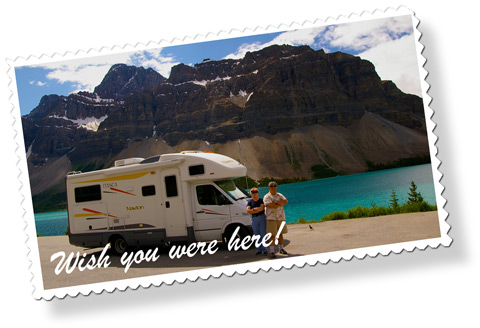
We bought our 2006 Itasca Navion 23J from the original owners, and though they provided the full Winnebago documentation carry bag, I continue to solve mysteries about the various systems to this day.
One of the early mysteries: why didn't the water get hot when you turned on the switch labeled "WATER HTR 110V" (and connected to shore line power)? The switch's pilot light would light, but then, the switch would illuminate in the “on” position whether there was shoreline power or not. I eventually determined that our Navion’s water heater is a propane-only Atwood G6A-8E WIN model. Which was fine, except that there was a switch on the wall that lit up when you turned it on (it’s actually a 12 volt pilot light, so it lights even when you don't have AC power to run a water heater). Why install a switch that lights up, when the thing it controls doesn’t exist? Wouldn’t it save Winnebago some money NOT to install the switch?
On what turned out to be a related note, our Navion did have UltraHeat holding tank and pipe elbow heaters (which I discovered while crawling around underneath installing our Sani-Con system), but no apparent way to turn them on. We live in Southern California, and traveled to colder regions only in summer for our first year and a half of ownership, so I never had to worry about freezing. But when we finally did our first winter trip to our home state of North Carolina, I started to wonder what was going on with the holding tank heaters. Was there a switch I never located? Were they just automatic? I think the only documentation provided for the tank heaters was warranty information. UltraHeat’s website provided no further clues about how the device might be installed in any particular instance, but did indicate that a power switch was necessary. (The tank heaters have built-in thermostatic controllers, turning them on at 44°F and off at 64°F, but UltraHeat advises against leaving them turned on in warmer conditions and if the tanks are empty. The pipe elbow heaters have no thermostatic control, and are always on when power is applied.)
I don't remember if I saw a photo of a 2006/7 View/Navion Systems Monitor Panel (the panel in our 2006 “J” is on the forward wall of the wardrobe, above the stove top) which HAD a tank heater switch, or what it was that inspired the idea, but one day it hit me: maybe the wiring for the tank heaters was in the wall where the useless 110 volt water heater switch was, and maybe the switches were identical (except for silkscreened labels). I took out the monitor panel and found exactly what I was looking for in the wiring harness:
(click and hold on any images on this page to enlarge them)
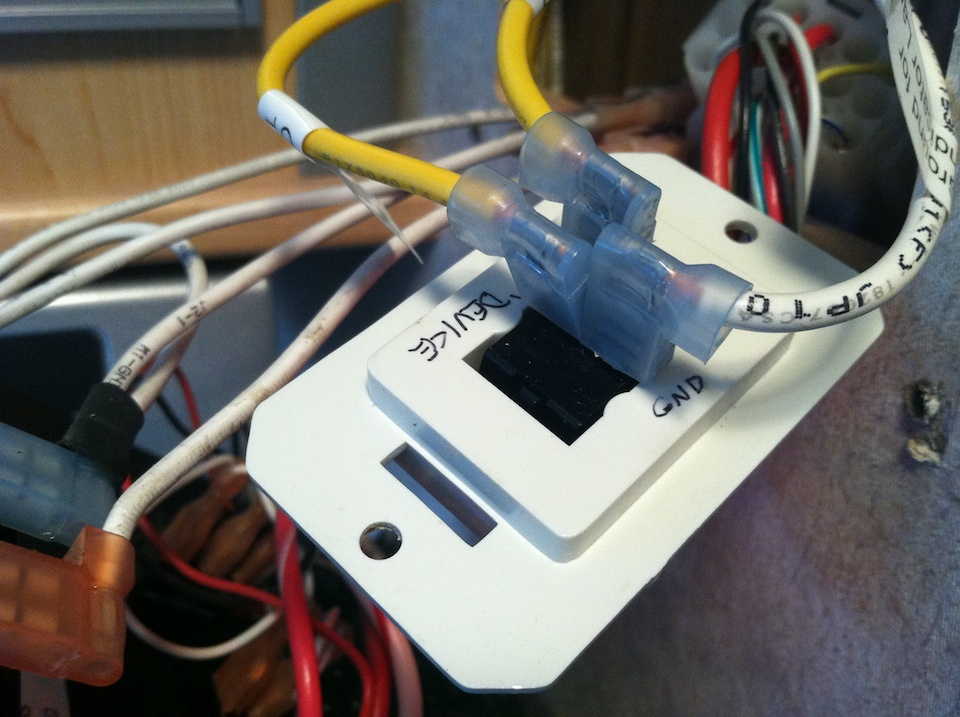 |
Testing the wires found inside the wall between the galley and the wardrobe. |
I connected the two YELLOW and one WHITE wire to the “WATER HTR 110V” switch (after determining which connectors on the switch were for switching and powering the pilot light) and installed the #5 fuse. When I turned the switch on (shorting the two yellow wires), its pilot lit. When I measured the pipe elbow heater with an infrared thermometer, it quickly heated to 135°F. (UltraHeat’s installation instructions explain how to test the thermostatically-controlled tank heaters with a bag of ice or dry ice. Weather turned cool enough here in SoCal the next morning that I could test the tank heaters without ice.)
After some research in a Winnebago parts catalog and a few other PDF files, I ordered the following parts to get what is essentially a duplicate switch to the 110V water heater switch, except that this has a “Holding Tank Heater” sticker (a WGO numbered part, yet), rather than the silkscreened label of the water heater switch.
I cut a hole in the wall immediately to the right of the existing water heater switch and installed the new switch there.
I installed a $100 Hott Rod electric water heater conversion - one of the most useful add-ons I've done.
It was tight getting the heating element's electrical connector in the confined drain-plug space.
Cutting off some of the styrofoam insulation from the hot water tank and attaching the thermostat was a bit fussy and awkward underneath the 23J’s wardrobe. And drilling a hole through the water heater’s burner mounting plate through which I routed the AC power cable was tricky.
The existing switch is not designed to control AC power (for that matter, there are no AC power switches in the Navion). To control the AC power, I chose to use a solid state relay. These are more expensive than mechanical relays, but I wanted the epoxy sealed package to avoid the potential danger that when a relay is mechanically crushed, it will bring DC and AC circuits physically into contact with one another, and therefore energize DC systems with AC current.
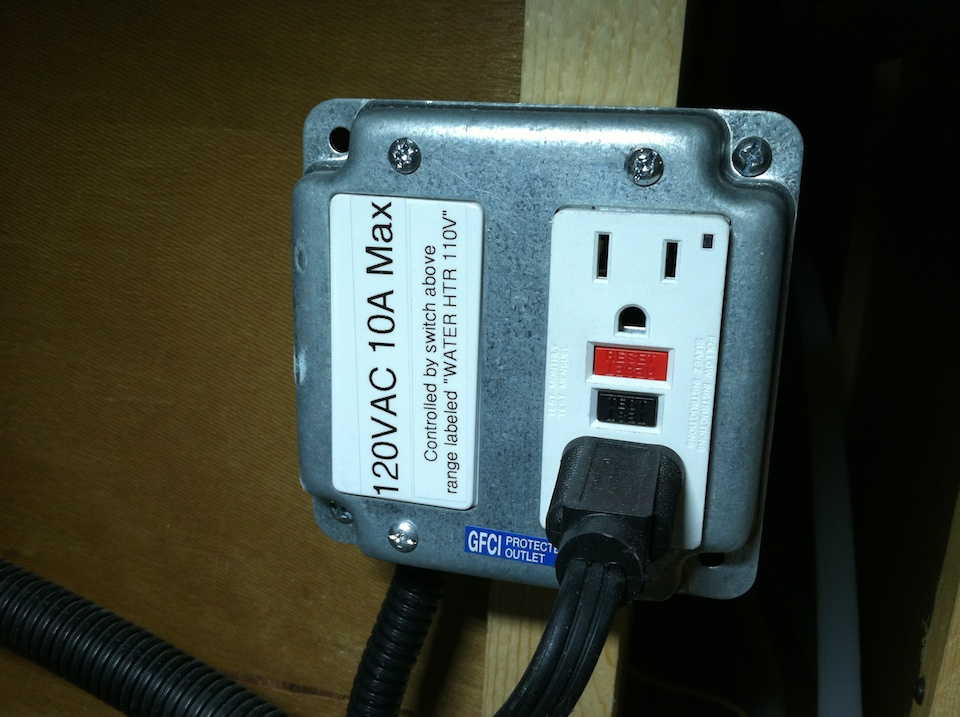 |
|
| When this solid state relay is triggered by a low-current 12VDC signal from the switch, 120VAC power passes through. | I mounted the solid-state relay and a ground fault circuit interrupter (GFCI) outlet in this box under the 23J's wardrobe. |
I installed a 10-amp solid state relay (the 450 watt Universal 6-gallon Hott Rod pulls about 4 amps) and a GFCI outlet under the J's wardrobe where the water heater is located. This allowed me to leave the Hott Rod's power cord unmodified, and I can unplug it entirely for safety, if desired.
I love not having to run propane when we’ve got AC power, and reduce the potential hazards of one more propane-powered device running - especially when the occupants are asleep.
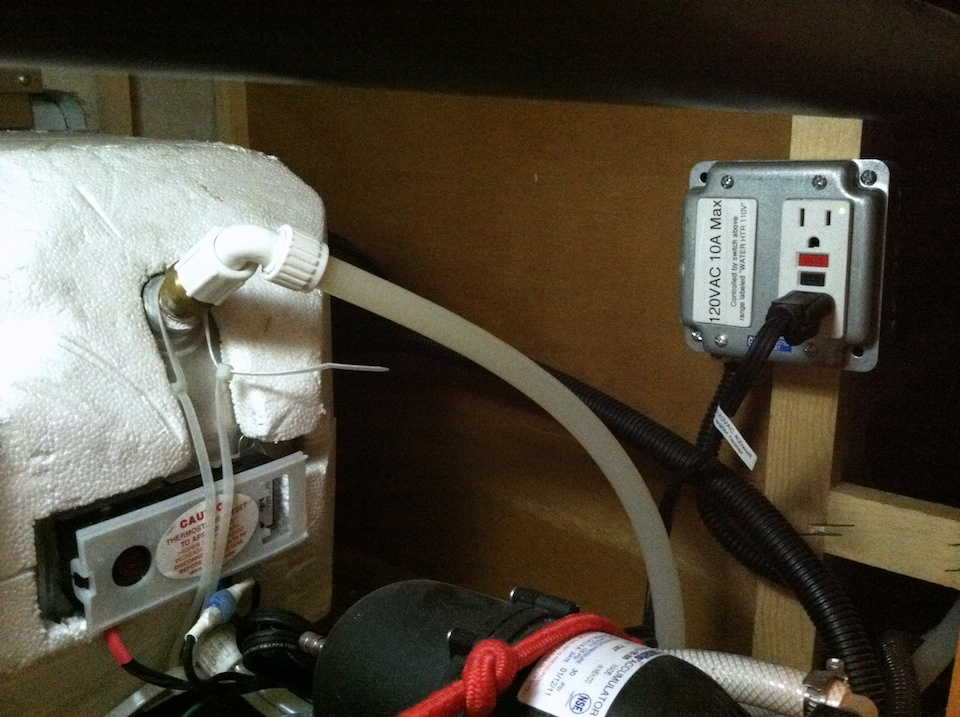 |
The thermostat and 12-volt controlled GFCI receptacle into which the Hott Rod is plugged. |
Now, our water heater switch actually controls a new electric water heater we didn’t have, and we have a new holding tank heater switch that turns on the holding tank heaters we always had, but could never turn on.
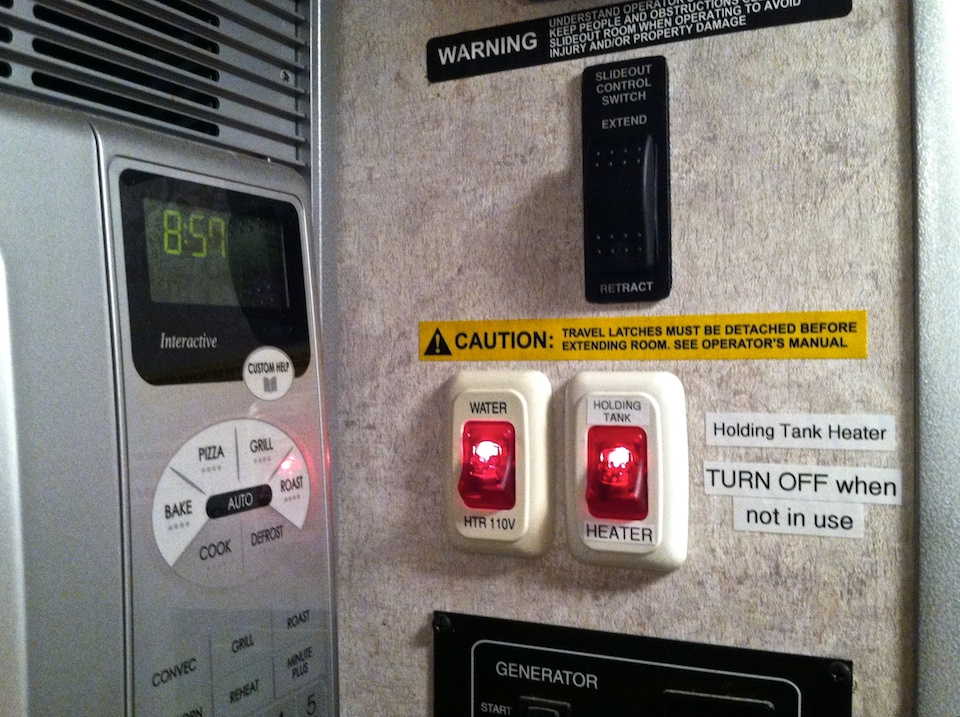 |
The new switch, located just to the right of the existing water heater switch. I ended up just sticking on my own tank heater labels, rather than using Winnebago's. |
I don’t know if this was an anomaly of the Winnebago production line, or normal practice. Certainly big mass-market product options are often installed during manufacture, and only made functional or visible if that option is desired by the distributor or customer. So I wouldn’t be surprised to find that Winnebago installed tank heaters in every vehicle, and only finished putting switches in vehicles on which the option was added to the vehicle’s “sticker.” But the weird combination: a water heater switch that lights up but controls nothing, and tank heaters that are installed but just need a switch “exactly” like the water heater switch - that’s a funny set of circumstances. And as low a production volume as even Winnebago has, I don’t think they need to be spending money on tank heaters on which they won’t be making money.
A fellow owner of a similar RV (a 2007 Winnebago View 23H) did have a holding tank heater switch, and holding tank heaters, but when he finally needed his heaters after owning the vehicle for years, they didn't work. He asked the other members of the View-Navion Tech forum where the relay was located, as he couldn't hear it when he operated the switch, and we chimed in with suggestions. The owner eventually found that the relay was taped to the top of his fresh water holding tank, and had never been installed. As though a Winnebago builder just forgot to finish the job. I've found many such artifacts that I think reflect the "boutique" nature of Winnebago. They may construct thousands of motorhomes, but they're not as rigidly structured a manufacturing facility as an automobile factory, and sometimes, it shows.
